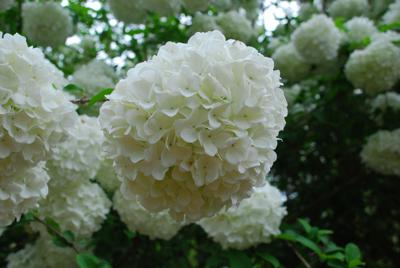As spring arrives, one particular shrub in my garden never fails to catch the eye of visitors. Without fail, someone will remark, “That’s the biggest hydrangea bush I’ve ever seen!” Others might say, “My hydrangeas haven’t even started blooming yet.” But here’s the surprise — it’s not a hydrangea at all.
It’s a viburnum. More specifically, this particular variety is Viburnum opulus, commonly known as the snowball bush. This impressive, multi-stemmed shrub produces large clusters of white flowers that resemble hydrangeas.

Each spring, it puts on a spectacular show, beginning with chartreuse blooms that gradually turn pure white as they mature. I’ve had mine for about 12 years, and every year it becomes more glorious. Viburnums are a diverse and fascinating group of shrubs and small trees.
With around 180 species native to North and South America, Europe, Asia and North Africa, their variety is astounding. They can be deciduous or evergreen, and many varieties are known for their delightfully fragrant flowers. My introduction to viburnums came by way of a Mother’s Day gift from my daughter-in-law, Laura.
Not long after she moved into her new home, she invited me to walk through her garden. As we strolled, I was enchanted by the scent of a shrub I didn’t recognize. Later, Laura took a cutting to a local nursery to identify it and bought one for me.
It turned out to be a Viburnum carlesii, also known as "Korean Spice." I was thrilled. Now, my Korean Spice viburnum stands about 10 feet tall and fills the air each spring with its sweet, clove-like fragrance — often before you even spot the plant.
That one experience was all it took to spark my love for viburnums. Viburnums range widely in size, from petite 2-foot shrubs to stately 30-foot trees. Their blooms can be bold and showy, delicate lacecaps or deliciously fragrant.
Most flowers are white, though some carry a hint of pink. While some viburnums are prized for their floral displays, others dazzle in autumn with colorful berries. This cultivar was rightly honored with the Pennsylvania Horticultural Society’s Gold Medal Plant Award in 1993.
The Viburnum opulus remains the show-stopper in my garden. It stands at about 15 feet tall and half as wide, with blooms that begin apple-green, transition to white and often take on a pinkish hue as they fade. While it lacks fragrance, the dramatic size of the blossoms more than makes up for it — no wonder it’s so often mistaken for a hydrangea.
Another favorite of mine is Viburnum × burkwoodii "Mohawk." Its spicy, clove-scented blooms and compact habit make it a standout in any garden. The reddish buds are a delight even before they open, and in autumn its dark green leaves shift to brilliant shades of orange and red.
This cultivar was rightly honored with the Pennsylvania Horticultural Society’s Gold Medal Plant Award in 1993. If you're in search of a compact evergreen with year-round appeal, look no further than "Moonlit Lace." This charming shrub features a dense, mounding form with glossy, leathery green leaves and red-tinged new growth.
In spring, it produces lacy clusters of tiny pink buds that open into showy white flowers. Perfect for borders or foundation plantings, "Moonlit Lace" offers both beauty and versatility in a manageable size. Viburnum tinus, also known as Laurustinus viburnum, is another beautiful addition to the garden.
While it isn’t as cold-hardy as some other varieties, it has done well for me in a more sheltered spot. Its foliage is reminiscent of bay laurel: glossy, dark green and particularly attractive through the winter months. The white flowers, tinged with soft pink, are lightly fragrant and add delicate charm in early spring.
I’ve had a small group of Viburnum tinus shrubs for about 10 years, and in my Zone 7 garden they’ve reached around 5 feet tall. In warmer zones, typically Zones 8 through 10, these shrubs can grow up to 10 feet. Their moderate size, evergreen presence and subtle beauty make them a great choice for protected borders or near entrances where their winter interest can be enjoyed.
Viburnums range widely in size, from petite 2-foot shrubs to stately 30-foot trees. One of the reasons I’ve come to appreciate viburnums so much is their ease of care. With such a wide range of species and varieties, there’s bound to be one that suits just about any garden style or condition.
They are generally pest- and disease-resistant. I’ve personally never had any problems with mine. I suspect much of that success comes from placing them where they’re happiest — locations with well-drained, slightly acidic, moist but not soggy soil and at least six hours of sunlight a day.
Viburnums typically don’t require regular pruning. When I do prune mine, it’s usually in winter while the plants are dormant. The exception is Viburnum tinus, which should be pruned in the spring after it has finished blooming to preserve next year’s flower buds.
Even with all I’ve shared, I’ve only just scratched the surface of the viburnum world. There are so many more varieties to explore, each with its own charm — some with striking berries, others with intoxicating fragrance and all with seasonal beauty. So the next time you find yourself wandering through a garden center, ask someone to point you toward the viburnums.
And if you’re lucky enough to be there while they’re in bloom, you’ll see for yourself just how showy — or how sweetly scented — they can be..
Technology

You'll be surprised that this springtime beauty is not actually a hydrangea

As spring arrives, one particular shrub in my garden never fails to catch the eye of visitors who confuse it with a hydrangea. However, it’s not a hydrangea at all. It’s a viburnum, an impressive shrub with clusters of white...















